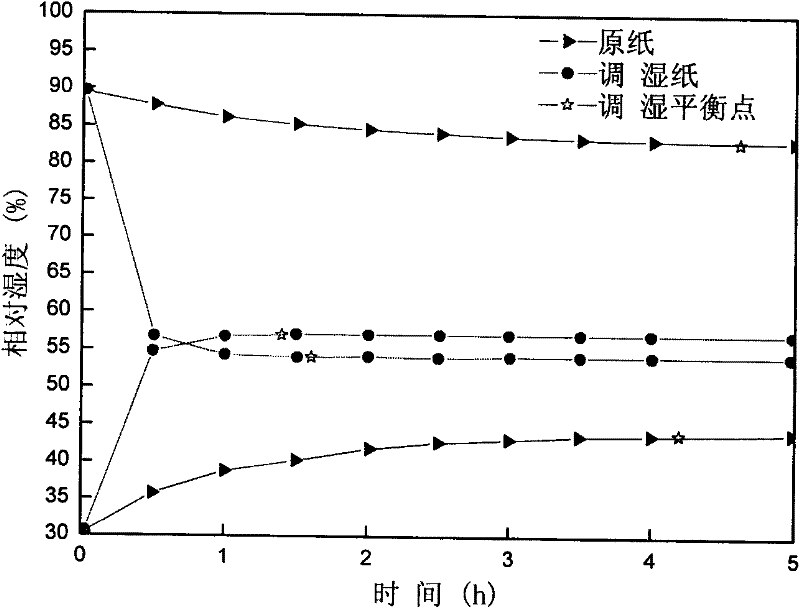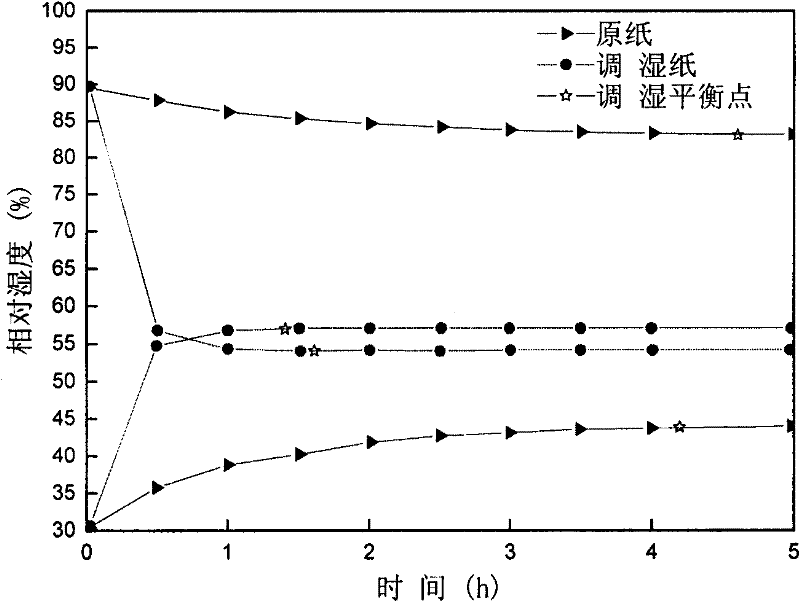Method for preparing high-efficiency composite humidifying paper
A moisture-regulating paper and high-efficiency technology, applied in special paper, paper, papermaking, etc., can solve the problems of uneven distribution of sepiolite, unfavorable packaging use, loss of raw materials, etc., to achieve diversified application methods, low cost, and breakage resistance The effect of increased intensity
- Summary
- Abstract
- Description
- Claims
- Application Information
AI Technical Summary
Problems solved by technology
Method used
Image
Examples
Embodiment 1
[0016] A preparation method of high-efficiency composite humidity-conditioning paper is characterized in that the following steps are adopted:
[0017] A) Get 15 parts of dry pulp by mass parts, 10 parts of acrylamide, 5.5 parts of sodium polyacrylate, 5.5 parts of carboxymethyl cellulose, 7 parts of sepiolite with a particle size of 100 mesh, 0.08 part of potassium persulfate, 0.015 part of N , N′-methylenebisacrylamide, added to 100 parts of water, and stirred and reacted for 5 hours at a temperature of 80° C., to obtain composite pulp;
[0018] B) dissociating the composite pulp in a fiber disintegrator to obtain pulp raw materials;
[0019] C) Paper pulp raw materials are directly made in a paper machine and dried to obtain high-efficiency composite humidity-controlling paper.
Embodiment 2
[0021] A preparation method of high-efficiency composite humidity-conditioning paper is characterized in that the following steps are adopted:
[0022] A) Get 20 parts of dry pulp by mass parts, 10 parts of acrylamide, 5.5 parts of sodium polyacrylate, 5.5 parts of carboxymethyl cellulose, 7 parts of sepiolite with a particle size of 100 mesh, 0.08 part of potassium persulfate, 0.015 part of N , N'-methylenebisacrylamide, added to 100 parts of water, at a temperature of 70 ° C, stirred and reacted for 4 hours to obtain composite pulp;
[0023] B) dissociating the composite pulp in a fiber disintegrator to obtain pulp raw materials;
[0024] C) Paper pulp raw materials are directly made in a paper machine and dried to obtain high-efficiency composite humidity-controlling paper.
Embodiment 3
[0026] A preparation method of high-efficiency composite humidity-conditioning paper is characterized in that the following steps are adopted:
[0027] A) Get 25 parts of dry pulp by mass parts, 10 parts of acrylamide, 5.5 parts of sodium polyacrylate, 5.5 parts of carboxymethyl cellulose, 7 parts of sepiolite with a particle size of 100 mesh, 0.08 part of potassium persulfate, 0.015 part of N , N'-methylene bisacrylamide, added to 100 parts of water, at a temperature of 60 ° C, stirred and reacted for 3 hours to obtain composite pulp;
[0028] B) dissociating the composite pulp in a fiber disintegrator to obtain pulp raw materials;
[0029] C) Paper pulp raw materials are directly made in a paper machine and dried to obtain high-efficiency composite humidity-controlling paper.
PUM
| Property | Measurement | Unit |
|---|---|---|
| strength | aaaaa | aaaaa |
Abstract
Description
Claims
Application Information
 Login to View More
Login to View More - R&D
- Intellectual Property
- Life Sciences
- Materials
- Tech Scout
- Unparalleled Data Quality
- Higher Quality Content
- 60% Fewer Hallucinations
Browse by: Latest US Patents, China's latest patents, Technical Efficacy Thesaurus, Application Domain, Technology Topic, Popular Technical Reports.
© 2025 PatSnap. All rights reserved.Legal|Privacy policy|Modern Slavery Act Transparency Statement|Sitemap|About US| Contact US: help@patsnap.com


